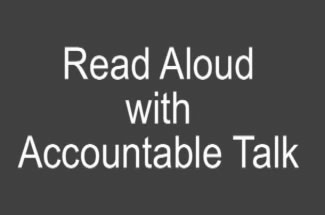Read aloud with accountable talk, also referred to as the interactive read aloud, is the instructional practice of reading to students. Reading aloud to students is a key component in any balanced literacy program. A daily read aloud allows teachers and students to enjoy good literature together. Reading aloud daily, both fiction and nonfiction, helps readers develop an appreciation of literature and the rhythm of the language. It is also an instructional practice that teachers use to model both decoding and comprehension strategies. During a read aloud, teachers will stop at the end of a chapter or at some other natural stopping point and give students time to reflect and share their thinking. Sometimes, students will be asked to talk with the classmate next to them, often referred to as a "turn and talk partner," and at other times students will be asked to jot down their thinking.
Instruction during read aloud time models and promotes focused conversation. Richard Allington (2002), a highly respected author of professional texts on literacy, has noted that classroom talk is critical to reading instruction. He describes observing an effective interactive read aloud as, "The classroom talk we observed was more often conversational than interrogational. Teachers and students discussed ideas, concepts, hypotheses, strategies, and responses with one another."
As a way to promote and initiate conversation during a read aloud, teachers prompt students to think deeply about texts and ask questions such as:
- What are you picturing in your mind as you read? (Visualizing)
- What does this remind you of from your own life? How might that help you understand the book better? (Making connections)
- Does this remind you of anything else you've read? How might that help you when you are reading this book? (Making literature connections)
- What did you learn about the character during this reading? How do you know? How is the character changing? (Recognizing character development)
- What questions do you have? (Questioning)
- What do you notice about the way the author wrote the book? What makes it effective? (Noticing literary elements)
- What are the powerful words or phrases that the author use? What makes them powerful? (Recognizing powerful language)
Listening and responding to stories read aloud is critical because it affords students the necessary support and practice for transferring these targeted thinking and conversational skills to the work of their book clubs, reading partnerships and independent reading.
Humane Education Annotated Booklist
Building Bridges/Disability Awareness Annotated Booklist
Read Aloud with Accountable Talk
Fisher, B. & Medvic, E. (2000). For Reading Out Loud. Portsmouth, NH: Heinemann.
Nichols, M. (2006). Comprehension Through Conversation. Portsmouth, NH: Heinemann.
Keene, E. (2008). To Understand: New Horizons in Reading Comprehension. Portsmouth, NH: Heinemann.
Keene, E. & Zimmerman, S. (1997). Mosaic of Thought: The Power of Comprehension Instruction (2nd edition). Portsmouth, NH: Heinemann.
Laminack, L. & Wadsworth, R. (2006). Reading Aloud Across the Curriculum. Portsmouth, NH: Heinemann.
Wilhelm, J. (2001). Improving Comprehension With Think-Aloud Strategies. New York, NY: Scholastic.

